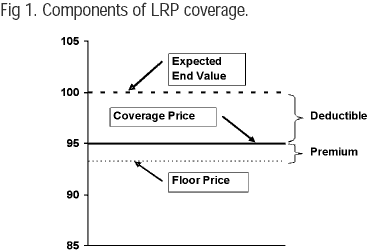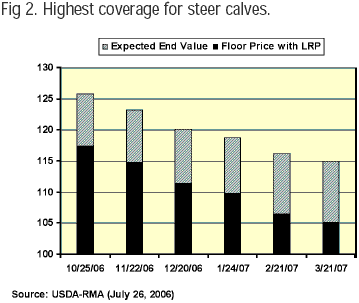



Livestock Risk Protection: Insuring Calves
By Matthew A. Diersen, Extension risk and business management specialist - Historically high cash prices for calves, general price volatility, and concern that prices may move lower may lead producers to insure calf prices. Livestock Risk Protection (LRP) is an insurance program that covers a single peril: lower prices.
Livestock Risk Protection (LRP) is an insurance program that covers a single peril: lower prices.LRP is still a pilot program with a small federal subsidy on the premiums. Insurance agents sell the policies. LRP coverage settles to cash prices, so there are no delivery concerns and generally reduced basis risk compared to other tools. When the coverage ends, LRP pays an indemnity if the market price has fallen below the coverage price.
Cow-calf producers are likely to be most interested in the LRP-Feeder Cattle policy, which can be specified to cover calves expected to weigh less than 600 pounds when the coverage ends. Calf prices are determined using price adjustment factors to feeder steer prices that act as price slides or basis additions.
LRP is appealing for use on calves because there is no minimum number of head to cover, making coverage cheaper than other tools such as put options. Producers can also cover calves under shared ownership arrangements with LRP. The coverage is available from 13 to 52 weeks out, depending on whether underlying feeder cattle contracts are trading.
How LRP works
A floor price is available for a given end date and type of cattle. Generally, the shortest end dates are routinely quoted. To assess the coverage available, a producer should decide when the cattle will be marketed (or how long the coverage is desired). Then, the LRP quotes are examined to determine if an end date within 30 days of the marketing date is offered. For a given end date there will be an expected end value for a given type of cattle that tracks futures prices. For example, the expected end value may be $100 per cwt (Fig 1).
For each end date there may be multiple coverage levels available, corresponding to different deductible levels. The largest coverage level is limited to 95% of the expected end value, corresponding to a 5% deductible. In the example, the maximum coverage occurs at the 95% level, giving a coverage price of $95 per cwt (Fig 1).
LRP indemnity payments are figured relative to the coverage price. If prices fall by the end date, then LRP pays any difference if the actual end value is below the coverage price. In the example, if the actual end value falls to $92 per cwt, then LRP would pay $3 per cwt or the difference between $92 per cwt and $95 per cwt. The end value is the national feeder steer price observed on the end date (with any price adjustment factors applied).
The coverage comes at a cost. LRP premiums generally track options prices, with a small subsidy. Premiums are paid at the time the coverage is purchased. Thus, the cost of LRP is incurred regardless of what happens to cattle prices by the end date. The premium should thus be subtracted off the coverage price to arrive at the floor price. For example, if the premium (after the subsidy) is $2 per cwt, the floor price would be $93 per cwt (Fig 1). Note that all the cattle prices and premiums are set based on national prices. The selling price for calves the producer receives does not affect the insurance. A producer's basis would ultimately affect the floor price, but only because of local quality or market conditions.
Additional considerations
In late July 2006, coverage was available with end dates for late October of 2006 through late March of 2007 (Fig 2). Under the LRP-Feeder Cattle policy, prices for steers expected to weigh less than 600 pounds by the end date are adjusted by 110% of heavier steer prices.
For steer calves as of July 26, the expected end values ranged from $125 to $115 per cwt, with corresponding floor prices ranging from $117 to $105 per cwt. For end date November 22, 2006, the expected end value was $123.21 per cwt, roughly 110% of the November feeder cattle futures price. The highest coverage level was just below 95%, giving a coverage price of $116.61 per cwt. The premium cost was $2.16 per cwt or $1.88 per cwt after the subsidy. The floor price was thus $114.73 per cwt. If feeder steer prices on November 22, 2006, multiplied by 110%, fall below the coverage price, then LRP pays an indemnity.
During fiscal year 2006, producers in South Dakota purchased 230 LRP-Feeder Cattle policies, insuring 27,864 head. The number covered in South Dakota reflects a small portion of the calf crop of 1.72 million head. Producers paid $233,925 in premiums and received $20.5 million in coverage. The average cost for coverage was $8.40 per head. Low cattle prices during the first half of 2006 resulted in indemnity payments on 72 policies totaling $184,676.
LRP is not without its faults. Because it is a pilot program, sales may be suspended if price risk becomes too large. The short duration (13 weeks) may limit the time during the year that cow-calf operators would find useful coverage available. The 30-day window to make cash sales may not fit if drought conditions move up marketing dates. Technically, LRP coverage can be sold to an eligible buyer of the cattle and be valued like an option. The large deductible may be undesirable and LRP rules make it difficult to combine LRP with certain other marketing strategies.
February 2007


